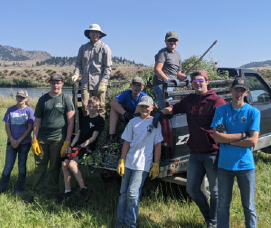2020 Restoration Actions of the Upper Missouri Watershed Alliance
Report prepared by Pat Hunter and Joe Kerkvliet
September 6, 2020
The Upper Missouri Watershed Alliance (UMOWA) has two ongoing streambank restoration projects on the Missouri River near Craig, Montana and two future projects in the planning stages. Despite the disruptions caused by the Covid 19 pandemic, UMOWA discontinued this restoration work during summer 2020.
PROJECT #1 | MACLIN PROPERTY
In 2019, UMOWA, Helena Scouts Troops 214, 207, and 217, Montana Audubon, Gardenwerks of Helena, and landowner Suzie Maclin initiated a restoration project on 700 feet of Missouri river streambank. The property is owned by Ms. Maclin and located about six miles downstream from Craig, Montana.
Activities in 2019 consisted of cutting and disposing of 40-50 invasive Russian Olive (Elaegnus agustifdia) trees growing on the riverbank, construction of ten 5’ by 10’ by 4’ high wire mesh enclosures near the riverbank, planting of 60 containerized native plants (wild rose, chokecherry, current, snowberry, buffalo berry, three-leaf sumac, service berry) inside the enclosures, and planting of three 8’ tall narrowleaf cottonwood trees (populous balsamifere ssp. Trichocarpa) inside
individual 6’ high wire protectors. The plants and trees were irrigated several times during summer 2019 and the 12 re-sprouted Russian Olives were cut in fall 2019.
During summer 2020, the plants and trees were irrigated once in July and once in August. Four UMOWA board members spent an entire day weeding and clipping competitive plants inside the exclosures and pulling and disposing of invasive species alone the entire 700 feet of riverbank. The invasive species removed included Russian knapweed, spotted knapweed, leafy spurge, Russian thistle, and hoary allysium.
On-site inspection of the project during 2020 revealed the following:
- None of the Russian Olive trees has re-sprouted following the cutting in summer and fall 2019.
- Over 90 percent of the planted native plants survived and were, for the most part, growing vigorously,
- Two of the three narrowleaf cottonwood trees survived and both of trees had grown to over 8 feet tall;
- The enclosures provided grazing protection that allowed several native shrubs to volunteer inside the enclosures. Species that volunteered included quaking aspen, chokecherry, dogbane, and narrowleaf cottonwood.
Photo: UMOWA Board Members (left to right: Pete Peterson, Bill Ryan, and Pat Hunter) at Maclin Project weedpull.

PROJECT #2 | WOLF CREEK BRIDGE
UMOWA initiated the Wolf Creek Bridge restoration project in 2018, by planting 70 containerized native shrubs in ten, 5 by 10 by 4 foot high enclosures, 50 shrubs planted with individual 3 foot high wire mesh protectors, and 20 with only a rebar marking. In addition, in December 2018, a 4 strand, barbed wire fence was installed along the entire 1200 feet of Missouri River bank, and two watergaps were constructed. The project was supported by UMOWA, Northwestern Energy, Gardenwerks of Helena, Montana Fish, Wildlife and Parks, landowner Stevie Neuman, and Helena Scout Troops 214, 207, and 217.
The plants were irrigated more than a dozen times during summer and fall 2018. During 2019, the plants were irrigated six times, UMOWA members performed maintenance on the enclosures and wire mesh protectors, and UMOWA conducted a limited weed pull.
During summer 2020, UMOWA conducted two weed pulls, utilizing the volunteer efforts of UMOWA board members, local volunteers, and Helena Scout Troops 214, 207, and 217.
Assessment of the Wolf Creek Bridge Project in 2020 found the following:
- Approximately 85 percent of the plants planted in 2018 have survived and many have attained heights of 3-6 feet;
- One enclosure was completely destroyed by a combination of grazing ungulates and sloughing of the riverbank, perhaps due to grazing;
- literally dozens of native plants have voluntarily sprouted from extant roots along the riverbank; this has probably occurred because grazing pressure was alleviated by the fencing. The vast majority of these volunteer plants are snowberry and wild rose, but one outstanding example is an 8 foot tall cottonwood
- The dominate causes of plant mortality appear to be a) grazing damage from ungulate grazing prior to barbed wire fence installation and b) planting too close to the river and subsequent inundation during high water flows.
Photo: Local volunteer next to 8 foot tall cottonwood at Wolf Creek Bridge Project



